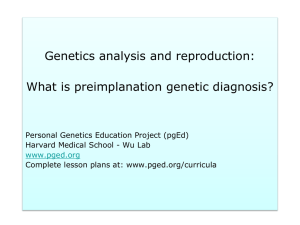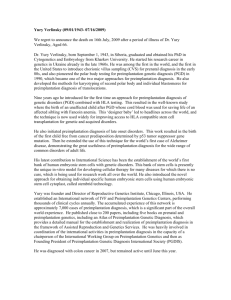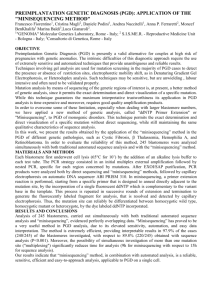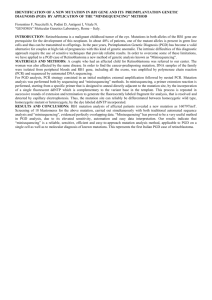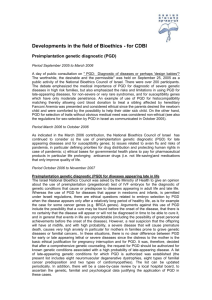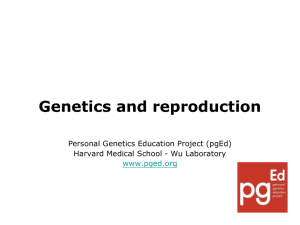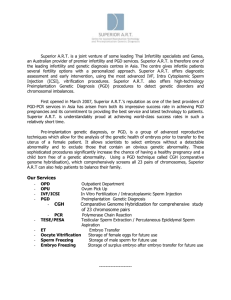RBM Online v8.2
advertisement
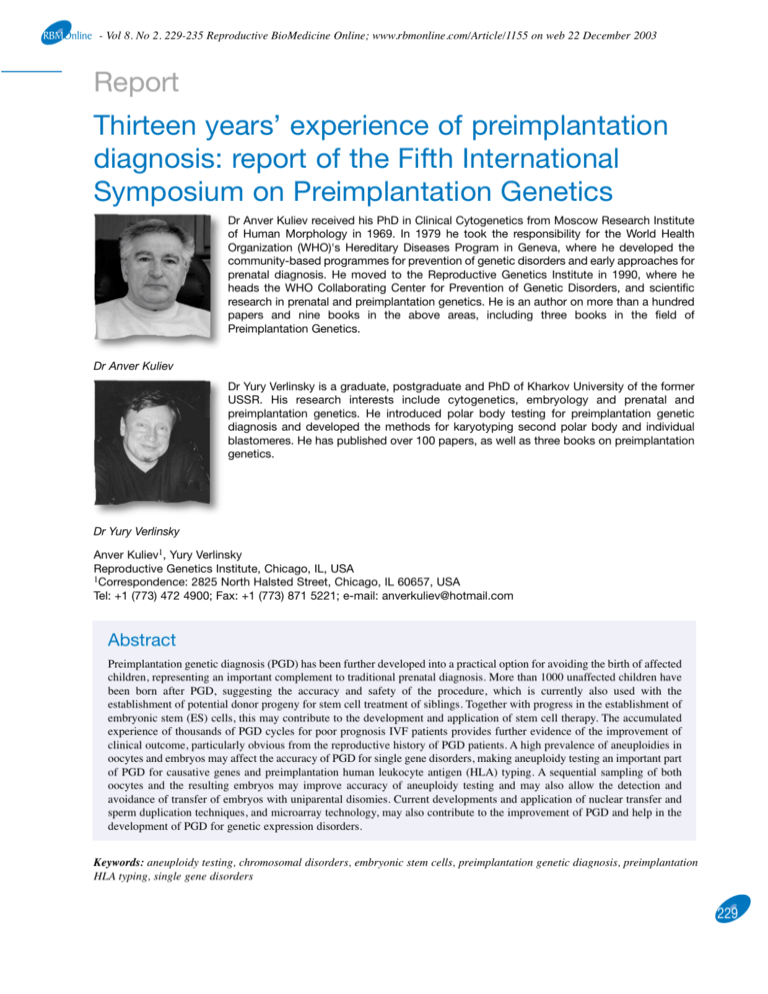
RBMOnline - Vol 8. No 2. 229-235 Reproductive BioMedicine Online; www.rbmonline.com/Article/1155 on web 22 December 2003 Report Thirteen years’ experience of preimplantation diagnosis: report of the Fifth International Symposium on Preimplantation Genetics Dr Anver Kuliev received his PhD in Clinical Cytogenetics from Moscow Research Institute of Human Morphology in 1969. In 1979 he took the responsibility for the World Health Organization (WHO)'s Hereditary Diseases Program in Geneva, where he developed the community-based programmes for prevention of genetic disorders and early approaches for prenatal diagnosis. He moved to the Reproductive Genetics Institute in 1990, where he heads the WHO Collaborating Center for Prevention of Genetic Disorders, and scientific research in prenatal and preimplantation genetics. He is an author on more than a hundred papers and nine books in the above areas, including three books in the field of Preimplantation Genetics. Dr Anver Kuliev Dr Yury Verlinsky is a graduate, postgraduate and PhD of Kharkov University of the former USSR. His research interests include cytogenetics, embryology and prenatal and preimplantation genetics. He introduced polar body testing for preimplantation genetic diagnosis and developed the methods for karyotyping second polar body and individual blastomeres. He has published over 100 papers, as well as three books on preimplantation genetics. Dr Yury Verlinsky Anver Kuliev1, Yury Verlinsky Reproductive Genetics Institute, Chicago, IL, USA 1Correspondence: 2825 North Halsted Street, Chicago, IL 60657, USA Tel: +1 (773) 472 4900; Fax: +1 (773) 871 5221; e-mail: anverkuliev@hotmail.com Abstract Preimplantation genetic diagnosis (PGD) has been further developed into a practical option for avoiding the birth of affected children, representing an important complement to traditional prenatal diagnosis. More than 1000 unaffected children have been born after PGD, suggesting the accuracy and safety of the procedure, which is currently also used with the establishment of potential donor progeny for stem cell treatment of siblings. Together with progress in the establishment of embryonic stem (ES) cells, this may contribute to the development and application of stem cell therapy. The accumulated experience of thousands of PGD cycles for poor prognosis IVF patients provides further evidence of the improvement of clinical outcome, particularly obvious from the reproductive history of PGD patients. A high prevalence of aneuploidies in oocytes and embryos may affect the accuracy of PGD for single gene disorders, making aneuploidy testing an important part of PGD for causative genes and preimplantation human leukocyte antigen (HLA) typing. A sequential sampling of both oocytes and the resulting embryos may improve accuracy of aneuploidy testing and may also allow the detection and avoidance of transfer of embryos with uniparental disomies. Current developments and application of nuclear transfer and sperm duplication techniques, and microarray technology, may also contribute to the improvement of PGD and help in the development of PGD for genetic expression disorders. Keywords: aneuploidy testing, chromosomal disorders, embryonic stem cells, preimplantation genetic diagnosis, preimplantation HLA typing, single gene disorders 229 Report - Report of the Fifth International Symposium on PGD- A Kuliev & Y Verlinsky Introduction With the expanding indications of preimplantation genetic diagnosis (PGD) and its wider application to assisted reproduction practices, the annual numbers of PGD cycles performed in the last two years have almost doubled. More than 1000 unaffected children have presently been born after PGD, indicating further improvement in the accuracy and reliability of this relatively novel procedure (Verlinsky et al., 2004). Introduced initially as an alternative to prenatal diagnosis, PGD has now also become an important complement to the presently available approaches for prevention of genetic disorders. Couples at risk for late onset diseases, or diseases that are not expressed in 100% of cases, or who require HLAmatched progeny previously would not risk a pregnancy because of the possible need to terminate it if prenatal diagnosis gave a positive result. Now PGD relieves couples in these categories of this worry. PGD has also stimulated improvements in the accuracy of single-cell genetic analysis. Sufficient progress has been achieved in PGD for aneuploidies and translocations, as a result of the introduction of novel and improved techniques. These developments were reviewed at the Fifth International Symposium, held in Antalya, Turkey on 5–7 June 2003. They are summarized below, with the emphasis on the following main topics: (i) improvements in PGD for single gene disorders; (ii) novel techniques for PGD; (iii) PGD for treatment of siblings requiring stem cell transplantation and progress in provision of human embryonic stem (ES) cells; and (iv) PGD impact on reproductive outcome. Improvements in PGD for single gene disorders 230 At least 1500 PGD cycles have been performed for single gene disorders, resulting in births of more than 300 unaffected children (International Working Group on Preimplantation Genetics (IWGPG), 2001; European Society of Human Reproduction and Embryology (ESHRE) Preimplantation Genetic Diagnosis Consortium, 2002; Harper, 2003; Verlinsky et al., 2004). Among a few new conditions for which PGD was reported were: Kell disease, familial dysautonomia, facioscapulohumeral muscular dystrophy, Canavan disease, and Sanjad–Sakati syndrome (Hellani et al., 2003; Malcov et al., 2003; Marshall et al., 2003; Rechitsky et al., 2003a; Verlinsky et al., 2003). This experience shows that some of the problems previously shown to result in misdiagnosis of single cell genetic analysis, such as contamination by extraneous DNA contamination or failed amplification, may now be well controlled, with reliable methods presently available for avoidance of misdiagnosis. However, some centres still work on the application of these methods to achieving PGD clinical outcome (Girardet et al., 2003; Jiao et al., 2003; Moutou et al., 2003), or concentrate on the development of PGD protocols (Bermudez et al., 2003; Fiorentino et al., 2003; Piyamongkol et al., 2003). Considerable progress has also been made in detecting preferential amplification and allele dropout (ADO), which may currently be avoided through the application of the multiplex nested polymerase chain reaction (PCR) analysis, involving mutation testing simultaneously with a number of closely linked polymorphic markers (Rechitsky et al., 2001, 2003b; De Vos et al., 2003; Goossens et al., 2000). Available experience strongly suggests that PGD protocols for single gene disorders may no longer be appropriate for clinical practice without a set of closely linked polymorphic markers tested simultaneously with causative genes. Because the availability of a sufficient number of closely linked informative markers cannot be predicted, especially in some populations or ethnic groups, the introduction of single nucleotide polymorphisms (SNP) as linked markers has improved considerably the chance of finding such markers (Sermon, 2003). The adequate number of informative linked markers, together with availability of a sufficient number of fluorochromes and the introduction of real-time PCR, substantially improves the accuracy of PGD, also making it possible to detect and avoid misdiagnosis due to recombination between the gene and markers and aneuploidies, which also present a potential source for misdiagnoses. A crossover rate of 4.3% within human leukocyte antigen (HLA) area has been observed in a recent experience of preimplantation HLA typing, involving a series of 330 preimplantation embryos (Rechitsky et al., 2003b; Verlinsky et al., unpublished data). The fact that aneuploidies in oocytes and embryos are highly prevalent has also been well known (Munné, 2002; Kuliev et al., 2003a), but their impact on the accuracy of PGD has not previously been fully appreciated. There is, however, no doubt that the accuracy of PGD may be compromised by copy number of the chromosome(s) in which the causative gene tested is localized, which is particularly important in PGD for single gene disorders offered for patients of advanced reproductive age, in whom the same biopsied single cell has to be simultaneously tested for the causative gene and specific chromosome number. Preliminary data, involving preimplantation HLA typing of 371 embryos, demonstrated that as many as 6.4% of the tested cells were aneuploid for chromosome 6, including 2.2% trisomic and 4.2% monosomic embryos, which may have led to misdiagnosis of HLA alleles, without evaluating the copy number of chromosome 6 (Verlinsky et al., unpublished data). The data suggest that reliable HLA typing, as well as PGD for single gene disorders, should involve testing for the copy number and the origin of missing or extra chromosomes in which the genes tested are localized. Novel techniques for PGD As previously demonstrated, the genetic composition of oocytes may be tested reliably through removal and testing of the first and second polar bodies (Verlinsky and Kuliev, 2000). However, no method has been available for testing the outcome of male meiosis, as genetic analysis destroys the spermatozoa, making them useless for fertilization. To overcome this problem, a new technique has been introduced, allowing the duplication of spermatozoa before genetic analysis so that one of the duplicated spermatozoa can be used for testing and the other for fertilization and consequent transfer of the resulting embryos, provided that the genetic analysis of the corresponding duplicate shows a normal genotype (Willadsen et al., 2003). To demonstrate the reliability of the technique, over 100 human spermatozoa from chromosomally normal donors, as well as from translocation carriers, were injected into enucleated mouse oocytes, and the duplicated cells resulting from an overnight culture were tested Report - Report of the Fifth International Symposium on PGD- A Kuliev & Y Verlinsky by fluorescence in-situ hybridization (FISH) to compare the chromosomal status of both daughter cells. All but 3% of the haploid cell pairs derived from the normal donors were identical for the chromosomes tested, while, as expected, a high proportion of the paired nuclei derived from the spermatozoa of translocation carriers were chromosomally unbalanced, suggesting that ooplasm from mature mouse eggs can support the faithful replication of any human sperm genome, irrespective of the genotype. Although it is still to be demonstrated whether human oocytes could duplicate spermatozoa as faithfully as murine oocytes, the technique may have important practical implications for PGD of paternally derived conditions, such as translocations, known to produce as many as 70% abnormal spermatozoa on average. The technique also has potential for research purposes, as shown in preliminary work devoted to the study of mosaicism (Munné et al., 2003a). Following duplication of human spermatozoa in cow oocytes, a series of 31 resulting embryos were cultured up to the 8-cell stage and tested by probes specific to chromosomes 13, 16, 18, 21 and 22. As many as 16% of the resulting sperm duplicates appeared not to be identical, which may further be related to the genetic differences between the donors involved. In fact, one of the three sperm donors for the above experiment produced mostly mosaic embryos in two PGD cycles. However, the rate of mosaicism in sperm duplicates of the three donors involved in this small series was similar, indicating that the generation of mosaic embryos, at least in patients previously tested by PGD, may be related not to the sperm genotype but to the sperm centrosome (Silber et al., 2002). There were also developments in the biopsy procedures for removing samples from oocytes and embryos, which may be required for improving the accuracy of PGD. For example, current PGD practice frequently requires removing the sample from both the oocytes and the resulting embryos, such as in PGD combined with preimplantation HLA typing, and combined PGD for single gene and chromosomal disorders. It is of interest that a preliminary evaluation of the outcome of such a double biopsy appeared to have no effect on the viability of the embryos (Magli et al., 2003). The approach has been applied on a regular basis as a tool for avoiding misdiagnosis due to mosaicism and has resulted in 26% pregnancy rate in IVF patients of advanced reproductive age (38.5 years on average) (Verlinsky and Kuliev, 2003). Finally, with the current tendency towards blastocyst transfer, there has been renewed interest in the development of methods for blastocyst biopsy, as demonstrated by successful PGD cycles performed by blastocyst biopsy for translocations, which have resulted in ongoing clinical pregnancies (McArthur et al., 2003). Although blastocyst biopsy is not yet a method of choice in many centres, its potential is obvious, especially for additional testing required to confirm the polar body or blastomere diagnosis. There was progress in the development of microarray technology in examining gene expression profiles of individual human oocytes and embryos, although no reliable correlation has been identified between molecular markers and developmental competence of oocytes and preimplantation embryos at the present time. By testing the expression profile of over 8000 genes examined in single oocytes and embryos, using Affymetrix GeneChip Microarrays, differences in the expression were evident even between oocytes of the same developmental stage, which may be due to underlying genetic differences that contribute to the patient’s phenotype (Steuerwald et al., 2003). The comparison of embryos at different stages of development revealed large divergences in gene expression, so microarray technology may help in revealing genes that play critical roles in specific infertile conditions and normal preimplantation development, thus providing potential targets for diagnosis. Customized microarray technology is presently being developed for the testing of chromosomal aneuploidies and translocations. However, the method is not yet sufficiently reliable for aneuploidy testing, requiring the improvement of the detection of ratio changes of 0.5 (Leigh et al., 2003). The method was applied for testing genomic DNA for gains and losses of chromosomal material in blocked morulae, showing different levels of mosaicism and aneuploidy for different chromosomes (Benkhalifa et al., 2003). Also a prototype microarray was developed for the detection of Robertsonian translocations, which may be applied in clinical practice, after further improvements to whole genome amplification to reduce loss of heterozygosity on low template DNA (Osborne et al., 2003). However, no significant progress was reported in the application of comparative genome hybridization (CGH) to PGD. CGH is still a highly labour-intensive procedure, incompatible with the current laboratory framework of PGD, even with the efforts to perform it on polar bodies, or to accelerate the procedure to be completed in 38 h (Wells et al., 2002; Ozen et al., 2003). Also, despite the expected higher aneuploidy detection rates detectable by CGH, no significant differences were reported (Wilton et al., 2003). In the majority of embryos tested by both FISH and CGH, the results were reported to be mainly in agreement, although a few inconsistencies were also reported (Ozen et al., 2003; Trussler et al., 2003). As for the available CGH clinical experience, it is still limited to a series of 20 poor prognosis IVF patients, involving CGH analysis of 141 embryos, which resulted in pre-selection and transfer of only 20 aneuploidy-free embryos in 14 cycles, yielding three clinical pregnancies (Wilton et al., 2003). This suggests that CGH is currently impractical for clinical application and requires further improvement. Further progress was achieved in the application of nuclear transfer techniques for PGD of translocations, with the current 83% success rate of blastomere nucleus conversion into metaphase. The method has been applied to 89 clinical cycles for translocation carriers, resulting in the transfer of balanced or normal embryos in 68 of them, which yielded 22 unaffected pregnancies (Verlinsky et al., 2002; Cieslak et al., 2003). Despite previous hopes for using nuclear transfer technology for producing female and male gametes through haploidization of somatic cells (Lacham-Kaplan et al., 2001; Tesarik and Mendoza, 2003), testing of the resulting presumably haploid cells by FISH analysis revealed chromosomal abnormalities in all but 5% of cells in preliminary results (Galat et al., 2003). This may suggest that, despite the feasibility of somatic cell haploidization by the use of the metaphase II oocyte 231 Report - Report of the Fifth International Symposium on PGD- A Kuliev & Y Verlinsky cytoplasm, its clinical use cannot be considered at the present time, due to an extremely high aneuploidy rate. PGD for treatment of siblings requiring stem cell transplantation and progress in provision of human embryonic stem cells Preimplantation HLA matching has been used during the last 3 years for the pre-selection of mutation-free embryos, which may also be potential donor progeny for bone marrow transplantation (Verlinsky et al., 2001; Kuliev and Verlinsky, 2002). Preimplantation HLA genotyping in combination with PGD was applied in more than two dozen cycles, resulting in pre-selection and transfer of the HLA-matched unaffected embryos in 17.5% of the embryos tested, as expected. The number of requests for performing PGD in combination with HLA typing has been increasing overall, with the recent emergence of a considerable proportion of cases involving preimplantation HLA typing without PGD. For example, in the presently available experience of 378 PGD cycles performed in the present authors’ centre in Chicago for 54 different conditions, including single gene defects, dynamic mutations and some medically relevant genetic variations, 45 (12%) cycles have been performed for HLA typing (Rechitsky et al. 2003b; Verlinsky et al., unpublished data). The number of HLA cycles in this experience was only 4 (0.5%) in 1999, when preimplantation HLA typing was first introduced, reaching 23 (19%) in 2002. While the majority of these cases (32 cycles) were done for preimplantation HLA genotyping in combination with PGD for causative genes, including thalassaemia (19 cycles), Fanconi anaemia (9 cycles), hyperimmunoglobulin M syndrome (2 cycles), X-linked adrenoleukodystrophy (one cycle) and Wiskott–Aldrich syndrome (one cycle), 13 clinical cycles have already been performed for HLA typing without PGD, i.e. with the only objective of pre-selecting of HLA-matched progeny for transplantation treatment of siblings with bone marrow disorders (Verlinsky et al., unpublished data). The latter cycles resulted in the embryo transfer of the HLA-matched embryos in 12 cycles, yielding the birth of five HLA-matched healthy children to become potential HLA-compatible donors for siblings requiring bone marrow transplantation. The data provide a realistic option for the couples desiring the establishment of a pregnancy potentially providing HLAmatched progeny for treatment of an affected family member, with the prospect of application of the approach to other inherited or acquired conditions, also requiring HLAcompatible donors for bone marrow transplantation. 232 Although preimplantation HLA typing is still controversial, and not allowed in certain countries, it has appeared to be so attractive for couples in need, that they have been prepared to achieve their goal in providing their affected siblings with HLA-matched donor progeny even by travelling out of the country. For example, PGD for genetic disease combined with HLA typing for sibling bone marrow rescue has been allowed in the UK, but HLA typing in the absence of high-risk genetic transmissible disease was not allowed (Braude, 2003). These couples requested preimplantation HLA typing abroad, which has presently resulted in the birth of HLA-matched progeny for their siblings with leukaemia or with sporadic Blackfan–Diamond anaemia (Verlinsky et al., unpublished data). Similarly, the law in the UK has condoned the use of embryos for stem cell research and therapeutic cloning, but this is still the subject of intense discussion in many other European countries with a strong lobby for a ban (Braude, 2003). In addition to the provision of HLA-matched stem cells for bone marrow disorders, PGD provides a novel source for the establishment of ES cells (Pickering et al., 2003). Although ES cells are usually derived from the culture of the inner cell mass (ICM) of the preimplantation blastocyst, a highly efficient and original technique was developed for the establishment of ES cell lines from human embryos of different stages of preimplantation development, without isolation and culture of ICM, and has been applied in the establishment of a dozen ES cell lines (Strelchenko et al., 2003). These ES lines, as well as other of ES lines established from spare human blastocysts obtained after PGD for chromosomal disorders, were characterized as typical pluripotent ES cells and were shown spontaneously to differentiate in vitro into a variety of cell types, including neurons and contracted cardiocytes. The established repository of ES cells is currently used for research purposes and is also available on request. As PGD allows genetic characterization of preimplantation embryos, prior to the formation of ES cells and their directed differentiation into different ES lineages, this may also improve the efficiency of the establishment of ES cells, which still vary greatly between laboratories. Of special relevance is the identification of factors influencing the differentiation of human ES cells, which is an essential prerequisite to their therapeutic application in regenerative medicine. For example, in the presence of an inhibitor of bone morphogenic proteins (NOGGIN), human ES cells were reported to form neurospheres that express classical neuronal markers (Cram et al., 2003). Under defined culture conditions, neurospheres are capable of differentiating into a variety of neural cell types, including astrocytes and oligodendrocytes. The fact that human ES cells may be induced to differentiate in vitro into somatic progeny, and that highly enriched cultures of proliferating neural progenitor cells may be isolated from differentiating human ES cells, was also reported (Reubinoff, 2003). The neural progenitors were differentiated in vitro into astrocytes, oligodendrocytes and mature neurons. Following transplantation to the developing brain, the human neural progenitors responded to host signals and were capable of constructing the neuronal and glial lineages. Controlling differentiation into pure populations of specific neural cells may eventually form the basis of therapy for some neurodegenerative disorders and spinal injuries. PGD impact on reproductive outcome An increasing number of centres have been involved in PGD for chromosomal disorders, including translocations and aneuploidies. As previously, significant reproductive impact was demonstrated in PGD for chromosomal translocations. The experience of more than 500 cycles accumulated at the present time further confirms the previous observations on a more than four-fold reduction of spontaneous abortion rate in translocation carriers, making PGD a preferred option for Report - Report of the Fifth International Symposium on PGD- A Kuliev & Y Verlinsky chromosomal translocations over traditional prenatal diagnosis (Munné, 2002; Verlinsky et al., 2002; Cieslak et al., 2003; Munné et al., 2003b). Further evidence has been accumulated on the positive clinical impact of PGD for aneuploidy, currently performed for advanced reproductive age, repeated IVF failures and repeated spontaneous abortions. Overall, the experience of close to 5000 PGD cycles for aneuploidy has been accumulated, with the majority of cases (approximately 4000 cycles) undertaken by the PGD centres in Chicago (Kuliev et al., 2003a; Verlinsky and Kuliev, 2003), St Barnabas, New Jersey (Munné, 2002; Munné et al., 2002, 2003c), Bologna (Gianaroli et al., 2001, 2003) and Istanbul Memorial Hospital (Kahraman, 2003). The positive clinical impact of aneuploidy testing has recently been documented in terms of doubling the implantation rate in IVF patients of 40 years and older, given a sufficient number of zygotes for testing (Munné et al., 2003c). The improvement in reproductive outcome was particularly obvious from the analysis of the reproductive history of PGD patients (Gianaroli et al., 2003). Analysing the outcome of the transfer of 318 FISH normal embryos, an implantation rate of 65.1% in pregnant patients was observed, with a total of 161 clinical pregnancies generated, which resulted in the birth of 153 children from 125 couples and 26 spontaneous abortions, giving a take-home baby rate of 82.3%. Of 161 couples involved in the study, 41 were on their first cycle, 14 had experienced 31 spontaneous pregnancies with 29 abortions and two deliveries, and there was only one birth in the remaining 27 couples. A total of 367 cycles were performed in 120 of these couples before undertaking PGD, with 30 pregnancies, five on term and 25 aborted. These couples had also experienced 50 spontaneous pregnancies, three on term and 47 aborted. The overall implantation rate derived from their reproductive experience was 13.0%, and the take-home baby rate 6.8%. This makes obvious the clinical usefulness of PGD for aneuploidy for IVF patients with poor reproductive performance. The potential of pre-selecting euploid embryos for transfer is in agreement with the fact that more than half of oocytes and embryos tested in PGD for poor prognosis IVF patients were shown to have chromosomal abnormalities. The analysis of prevalence and types of these anomalies may help to investigate their origin and improve the accuracy of PGD for aneuploidies. For example, based on the testing of 8213 oocytes by first and second polar body sampling in PGD for IVF patients of advanced reproductive age, it was observed that 53.1% of oocytes had aneuploidies for chromosomes 13, 16, 18, 21 and 22, with 39% of them originating from meiosis I, 32% from meiosis II, and 29% from both meiosis I and meiosis II errors (Kuliev et al., 2003a,b). One-third of the latter errors appeared to be ‘balanced’ for those chromosomes involved in errors in both meiosis I and meiosis II, but the follow-up analysis of the embryos resulting from these ‘balanced’ oocytes showed a normal chromosomal set in only 18% of cases, the remaining majority having aneuploidies, involving the errors for the same or different chromosomes, or mosaicism. This may suggest that any error in a female meiosis may lead to a predisposition to further errors at the cleavage stage, making the resulting embryos useless for transfer. The experience currently accumulated by FISH analysis of thousands of preimplantation embryos further confirms 50–70% prevalence of aneuploidies at the cleavage stage (Gianaroli et al., 2001, 2003; Munné, 2002; Kahraman, 2003). As previously demonstrated, at least half of chromosomally abnormal embryos have mosaicism, which is the major challenge in improving the accuracy of PGD for aneuploidies. As the overall prevalence of chromosomal abnormalities in oocytes and embryos seems to be comparable, suggesting that mosaic embryos may originate from aneuploid oocytes through the process known as ‘trisomy rescue’, further improvement of PGD accuracy may in future require testing of both oocytes and the resulting embryos. As mentioned previously, this may be achieved by a sequential biopsy of both polar bodies and a single blastomere from the resulting embryo, so that both meiotic and mitotic errors could be excluded. In addition, information from both the oocyte and the embryo chromosome sets will make it possible to detect the potential uniparental disomy cases, which will be evident from the detection of the normal disomic embryos, originating from trisomic oocytes. Collecting of this unique information may also be useful in finding a possible explanation for at least some of the cases of Beckwith–Wiedemann syndrome (BWS), reported recently in an association with assisted reproduction techniques (DeBaun et al., 2003; Maher et al., 2003; Gicquel et al., 2003). The fact that more than half of IVF patients are 35 years and older, and that more than half of their oocytes have aneuploidies, avoiding the transfer of the embryos resulting from these oocytes through PGD for aneuploidies should be useful, in addition to potentially improving implantation and pregnancy rates, for avoiding the transfer of embryos with uniparental disomies, as possible contributors to the imprinting disorders. The Inaugural Meeting of the Preimplantation Genetic Diagnosis International Society (PGDIS) was held during the Fifth International Symposium on Preimplantation Genetics, the participants of which became founding members, along with the participants of the previous 4th International Symposium on Preimplantation Genetics in Cyprus, 2002. The 6th International Symposium on Preimplantation Genetics will be organized now by PGDIS and is scheduled for 19–22 May 2005, with the celebration of millions of IVF and thousands of PGD babies (http://www.pgdlondon.org). Note: Many of the references quoted in this article refer to the papers delivered at the Symposium. References Benkhalifa M, Mucci M, Kahraman S et al. 2003 Genome profiling of blocked morulaes: technical validation using bacterial artificial chromosomes microarray. Fifth International Symposium on Preimplantation Genetics, 5–7 June, Antalya, Turkey, P21–22 (abstr.). Bermudez MG, Piyamongkol W, Tomaz S et al. 2003 Single-cell sequencing and mini-sequencing for preimplantation genetic diagnosis. Prenatal Diagnosis 23, 669–677. Braude P 2003 Use of embryos for tissue matching and human reproductive cloning. Fifth International Symposium on Preimplantation Genetics, 5–7 June, Antalya, Turkey, P41 (abstr.). Cieslak J, Zlatopolsky Z, Galat V et al. 2003 Preimplantation diagnsosi in 146 cases of chromosomal translocations. Fifth 233 Report - Report of the Fifth International Symposium on PGD- A Kuliev & Y Verlinsky 234 International Symposium on Preimplantation Genetics, 5–7 June, Antalya, Turkey, P23 (abstr.). Cram D, Hawes S, Pera M, Trounson A 2003 Human embryonic stem cells. Fifth International Symposium on Preimplantation Genetics, 5–7 June, Antalya, Turkey, P34 (abstr.). De Vos A, Sermon K, De Rijcke M et al. 2003 Preimplantation genetic diagnosis for Charcot–Marie–Tooth disease type 1A. Molecular Human Reproduction 9, 429–435. DeBaun MR, Niemitz EL, Feinberg AP 2003 Association of in vitro fertilization with Beckwith-Wiedemann syndrome and epigenetic alterations of LIT1 and H19. American Journal of Human Genetics 72, 156–160. European Society of Human Reproduction and Embryology (ESHRE) Preimplantation Genetic Diagnosis Consortium. 2002 Data Collection III, May 2002. Human Reproduction 17, 233–246. Fiorentino F, Magli MC, Podini D et al. 2003 The minisequencing method: an alternative strategy for preimplantation genetic diagnoisis of single gene disorders. Molecular Human Reproduction 9, 399–410. Galat V, Ozen S, Rechitsky L, Verlinsky Y 2003 Is haploidization by human mature oocytes real? Fifth International Symposium on Preimplantation Genetics, 5–7 June, Antalya, Turkey, P36–37 (abstr.). Gianaroli L, Magli MC, Ferraretti AP 2001 The in vivo and in vitro efficiency and eccicacy of PGD for aneuploidy. Molecular and Cellular Endocrinology 183, S13–18. Gianaroli L, Magli MC, Ferraretti AP 2003 PGD for aneuploidies: clinical outcome. Fifth International Symposium on Preimplantation Genetics, 5–7 June, Antalya, Turkey, P25 (abstr.). Gicquel C, Gaston V, Maldenbaum J et al. 2003 In vitro fertilization may increase the risk of Beckwith-Videmann syndrome related to the abnormal imprinting of the KCNQ1OT gene. American Journal of Human Genetics 72, 1338–1341. Girardet A, Hamamah S, Dechaud H et al. 2003 Specific detection of non-deleted dystrophin exons together with geneder assignment in preimplantation genetic diagnosis of Duchenne muscular dystrophy. Molecular Human Reproduction 9, 421–428. Goossens V, Sermon K, Lissens W et al. 2000 Clinical application of preimplantation genetic diagnosis for cystic fibrosis. Prenatal Diagnosis 20, 571–581. Harper JC 2003 ESHRE PGD consortium for Mendelian disorders. Fifth International Symposium on Preimplantation Genetics, 5–7 June, Antalya, Turkey, P18 (abstr.). Hellani A, Al-Aqueel A, Jaroudi K et al. 2003. Pregnancy after preimplantation genetic diagnosis for Sanjad-Sakati syndrome. Fifth International Symposium on Preimplantation Genetics, 5–7 June, Antalya, Turkey, P52 (abstr.). International Working Group on Preimplantation Genetics 2001 Preimplantation Genetic Diagnosis – Experience of Three Thousand Clinical Cycles. Report of the 11th Annual Meeting International Working Group on Preimlantation Genetics, in conjunction with the 10th International Congress of Human Genetics, Vienna, 15 May 2001. Reproductive BioMedicine Online 3, 49–53. Jiao Z, Zhou C, Li J et al. 2003 Birth of healthy children after preimplantation diagnosis of beta-thalassemia by whole-genome amplification. Prenatal Diagnosis 23, 646–651. Kahraman S 2003 PGD impact on IVF efficiency. Fifth International Symposium on Preimplantation Genetics, 5–7 June, Antalya, Turkey, P25–26 (abstr.). Kuliev A, Verlinsky Y 2002 Current feature of preimplantation genetic diagnosis. Reproductive BioMedicine Online 5, 296–301. Kuliev A, Cieslak J, Ilkevitch Y, Verlinsky Y 2003a Nuclear abnormalities in series of 6733 human oocytes. Reproductive BioMedicine Online 6, 54–59. Kuliev A, Cieslak J, Zlatopolsky Z et al. 2003b Origin of aneuploidies in preimplantation embryos. Fifth International Symposium on Preimplantation Genetics, 5–7 June, Antalya, Turkey, P16–17 (abstr.). Lacham-Kaplan O, Daniels R, Trounson A 2001 Fertilization of mouse oocytes using somatic cells as male germ cells. Reproductive BioMedicine Online 3, 205–211. Leigh D, Wright D, Stojanov T 2003 Development of customized microarrays for testing of chromosomal aberrations in human preimplantation embryos. Fifth International Symposium on Preimplantation Genetics, 5–7 June, Antalya, Turkey, P21 (abstr.). Magli MC, Ferraretti A, Gianaroli L et al. 2003 The combination of polar body and embryos biopsy does not affect embryo viability. Fifth International Symposium on Preimplantation Genetics, 5–7 June, Antalya, Turkey, P24 (abstr.). Maher ER, Brueton LA, Bowdin SC et al. 2003 BeckwithWiedemann syndrome and assisted reproduction technology (ART). Journal of Medical Genetics 40, 62–64. Malcov M, Yosef DB, Schwartz T et al. 2003 Preimplantation genetic diagnosis for Canavan disease. Fifth International Symposium on Preimplantation Genetics, 5–7 June, Antalya, Turkey, P43–44 (abstr.). Marshall J, Leigh D, McArthur S, de Boer K 2003 Preimplantation genetic diagnosis for facioscapulohumeral muscular dystrophy (FSHD). Fifth International Symposium on Preimplantation Genetics, 5–7 June, Antalya, Turkey, P19–20 (abstr.). McArthur S, Marshall J, Wright D, de Boer K 2003 Successful pregnancies following blastocyst (day 5) biopsy and analysis for reciprocal and Robertsonian translocations. Fifth International Symposium on Preimplantation Genetics, 5–7 June, Antalya, Turkey, p. 33 (abstr.). Moutou C, Gardes N, Viville S 2003 Duplex PCR for preimplantation genetic diagnosis (PGD) of spinal muscular atrophy. Prenatal Diagnosis 23, 685–689. Munné S 2002 Preimplantation Genetic Diagnosis of Numerical and Structural Chromosome Abnormalities. Reproductive BioMedicine Online 4, 183–196. Munné S, Cohen J, Sable D 2002 Preimplantation genetic diagnosis for advanced maternal age and other indications. Fertility and Sterility 78, 234–236. Munné S, Willadsen S, Schmmel T, Cohen J 2003a Nuclear sperm duplication as a tool to study mosaicism. Fifth International Symposium on Preimplantation Genetics, 5–7 June, Antalya, Turkey, P55–56 (abstr.). Munné S, Fisher J, Escudero T et al. 2003b Outcome of >100 cycles of preimplantation genetic diagnosis of translocations. Fifth International Symposium on Preimplantation Genetics, 5–7 June, Antalya, Turkey, P31 (abstr.). Munné S, Sandalinas M, Escudero T et al. 2003c Improved implantation after preimplantation genetic diagnosis of aneuploidy. Reproductive BioMedicine Online 7, 91–97. Osborne EC, Trounson AO, Cram DS 2003 Fifth International Symposium on Preimplantation Genetics, 5–7 June, Antalya, Turkey, P31 (abstr.). Ozen S, Rechitsky S, Chmura M, Verlinsky Y 2003 High-resolution genomic hybridization (CGH) using single-cell standards in single blastomeres deriving from oocytes with known PB1 and II FISH results. Fifth International Symposium on Preimplantation Genetics, 5–7 June, Antalya, Turkey, P45–46 (abstr.). Pickering SJ, Braude PR, Patel M et al. 2003 Preimplantation genetic diagnosis as a novel source of embryos for stem cell research. Reproductive BioMedicine Online 7, 353–364. Piyamongkol W, Bermudez MG, Harper JC, Wells D 2003 Detailed investigation of factors influencing amplification efficiency and allele drop out in single-cell PCR: implications for preimplantation genetic diagnosis. Molecular Human Reproduction 9, 411–420. Rechitsky S, Verlinsky O, Amet T et al. 2001 Reliability of preimplantation diagnosis for single gene disorders. Molecular and Cellular Endocrinology 183, S65–S68. Rechitsky S, Verlinsky O, Kuliev A et al. 2003a Preimplantation genetic diagnsis for familial dysautonomia. Reproductive BioMedicine Online 6, 488–493. Rechitsky S, Verlinsky O, Masciangelo C et al. 2003b Report - Report of the Fifth International Symposium on PGD- A Kuliev & Y Verlinsky Preimplantation non-disease testing. Fifth International Symposium on Preimplantation Genetics, 5–7 June, Antalya, Turkey, P17–18 (abstr.). Reubinoff B 2003 Human ES cells – a potential platform for cell and gene therapy. Fifth International Symposium on Preimplantation Genetics, 5–7 June, Antalya, Turkey, P34 (abstr.). Sermon K 2003 The improvement of accuracy in PGD for monogenic disorders: the Brussels experience. Fifth International Symposium on Preimplantation Genetics, 5–7 June, Antalya, Turkey, P17 (abstr.). Silber S, Sadowy S, Lehahan K et al. 2002 High rate of chromosome mosaicism but not aneuploidy in embryos from karyotypically normal men requiring TESE. Reproductive BioMedicine Online 4 (suppl. 2), 20. Steuerwald N, Bermudes MG, Wells D et al. 2003 The use of microarray technology to examine the gene expression profiles of individual human oocytes and embryos. Fifth International Symposium on Preimplantation Genetics, 5–7 June, Antalya, Turkey, P14 (abstr.). Strelchenko N, Verlinsky O, Kukharenko V, Verlinsky Y 2003 Establishment of RGI Reository of Human Embryonic Stem Cells. Fifth International Symposium on Preimplantation Genetics, 5–7 June, Antalya, Turkey, P34–35 (abstr.). Tesarik J, Mendoza C 2003 Somatic cell haploidization: an update. Reproductive BioMedicine Online 6, 60–65. Trussler JL, Pickering SJ, Ogilvie CM 2003 Investigation of chromosome imbalance in human embryos using comparative genomic hybridization (CGH). Fifth International Symposium on Preimplantation Genetics, 5–7 June, Antalya, Turkey, P46 (abstr.). Verlinsky Y, Kuliev A 2000 Atlas of Preimplantation Genetic Diagnosis. Parthenon, New York. Verlinsky Y, Kuliev A 2003 PGD-Dozen years experience. Fifth International Symposium on Preimplantation Genetics, 5–7 June, Antalya, Turkey, P13 (abstr.). Verlinsky Y, Rechitsky S, Schoolcraft W et al. 2001 Preimplantation diagnosis for Fanconi anemia combined with HLA matching. Journal of the American Medical Association 285, 3130–3133. Verlinsky Y, Cieslak J, Evsikov S et al. 2002 Nuclear transfer for full karyotyping and preimplantation diagnosis of translocations. Reproductive BioMedicine Online 5, 302–307. Verlinsky Y, Rechitsky S, Seckin O et al. 2003 Preimplantation genetic diagnosis for Kell Genotype. Fertility and Sterility 80, 1047–1051. Verlinsky Y, Munné S, Cohen J et al. 2004 Over a decade of preimplantation genetic diagnosis experience – a multi-center report. Fertility and Sterility in press. Wells D, Escudero T, Levy B et al. 2002 First clinical application of comparative genomic hybridization and polar body testing for preimplantation genetic diagnosis of aneuploidy. Fertility and Sterility 78, 543–549. Willadsen S, Munné S, Schmmel T, Cohen J 2003 Applications of nuclear sperm duplication. Fifth International Symposium on Preimplantation Genetics, 5–7 June, Antalya, Turkey, P35 (abstr.). Wilton L, Voullaire L, Sargent RM et al. 2003 Preimplantation aneuploidy screening using comparative genomic hybridization or fluorescence in situ hybridization of embryos from patients with recurrent implantation failure. Fertility and Sterility 80, 860–868. Received 13 October 2003; refereed 7 November 2003; accepted 14 November 2003. 235

